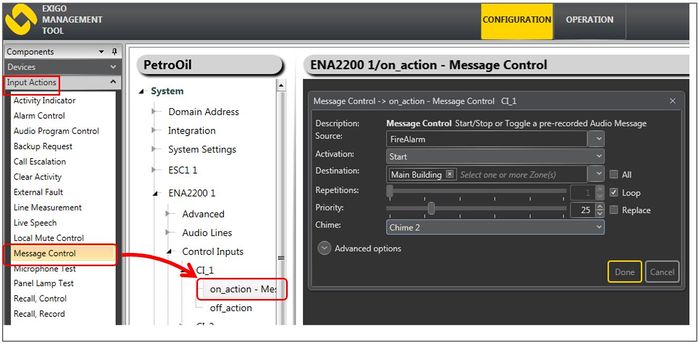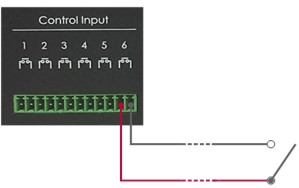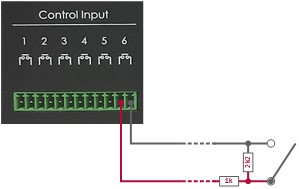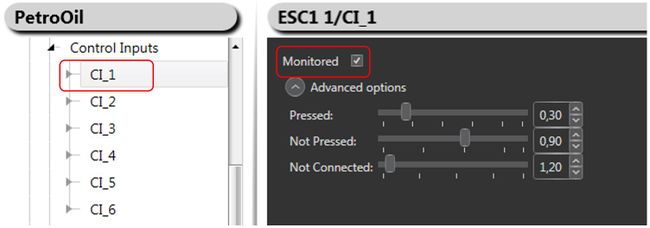Difference between revisions of "Control Inputs"
| (32 intermediate revisions by 3 users not shown) | |||
| Line 1: | Line 1: | ||
[[File:Control Inputs 1.JPG|thumb|right|350px|Devices with Control Inputs available]] | [[File:Control Inputs 1.JPG|thumb|right|350px|Devices with Control Inputs available]] | ||
| − | This article describes the | + | This article describes the Control Inputs on the Exigo system in general. <br> |
*'''Control Inputs''' are available on: | *'''Control Inputs''' are available on: | ||
| − | ** System Controller | + | ** [[ESC1|System Controller]] |
** Amplifiers | ** Amplifiers | ||
| − | ** Access Panels ('''Not''' | + | ** [[:Category:Access Panels|Access Panels]] and [[:Category:Kits|Kits]] ('''Not''' [[:Category:Ex Access Panels| Ex panels]]) |
* 6 inputs on each device | * 6 inputs on each device | ||
| − | * Inputs are used e.g. for triggering: | + | * Inputs are used, e.g. for triggering: |
** General Alarm | ** General Alarm | ||
** Fire Alarm | ** Fire Alarm | ||
** Live Speech from external microphone | ** Live Speech from external microphone | ||
| − | ==Control Inputs - Connections== | + | == Control Inputs - Connections == |
| − | '''Connections on | + | '''Connections on Rack Devices''' |
[[File:Control Inputs 2.JPG|thumb|left|700px|Rack devices]] | [[File:Control Inputs 2.JPG|thumb|left|700px|Rack devices]] | ||
<br style="clear:both;" /> | <br style="clear:both;" /> | ||
| − | '''Connections on | + | '''Connections on Access Panels''' |
| − | [[File:Control Inputs 3.JPG|thumb|left|700px| | + | [[File:Control Inputs 3.JPG|thumb|left|700px|Kits and access panels]] |
<br style="clear:both;" /> | <br style="clear:both;" /> | ||
| − | ==Configuration== | + | == Configuration == |
| + | Configuration of Control Inputs is done in EMT: | ||
[[File:Control Inputs 4.JPG|thumb|left|700px|Input 1 on amplifier starts «Fire Alarm» message in «Main Building»]] | [[File:Control Inputs 4.JPG|thumb|left|700px|Input 1 on amplifier starts «Fire Alarm» message in «Main Building»]] | ||
<br style="clear:both;" /> | <br style="clear:both;" /> | ||
* In '''Components''' view open '''Input Actions''' | * In '''Components''' view open '''Input Actions''' | ||
| − | * In '''System, identify the device and expand to '''Control Inputs''' | + | * In '''System''', identify the device and expand to '''Control Inputs''' |
| − | * Drag the desired '''Input Action''' to | + | * Drag the desired '''Input Action''' to '''on_action''' or the '''off_action''' |
* Set relevant parameters in the dialog box that appears | * Set relevant parameters in the dialog box that appears | ||
| + | == Control Inputs - Monitoring == | ||
| + | [[File:Control_Inputs_5.jpg|thumb|left|700px|Control Input]] | ||
| + | <br style="clear:both;" /> | ||
| + | * Conventional inputs have two states: | ||
| + | ** Contact is '''Open''' | ||
| + | ** Contact is '''Closed''' | ||
| + | This makes the control input vulnerable, i.e. cable break is not detected. <br> | ||
| + | On the '''System Controller''' and '''Amplifier''' it is possible to monitor the control inputs. Access panels do not support monitoring.<br> | ||
| + | This is done by connecting two resistors as close as possible to the external switch/relay, one in series and one in parallel. | ||
| + | [[File:Control_Inputs_6.jpg|thumb|left|700px|Control Input - Monitored]] | ||
| + | <br style="clear:both;" /> | ||
| + | The resistor connected in series with the external switch/relay shall have a value of '''1 kΩ''', while the resistor connected in parallel shall be '''2.2 kΩ'''. | ||
| + | |||
| + | Monitored Inputs have four states: | ||
| + | * Contact is Open | ||
| + | * Contact is Closed | ||
| + | * Short circuit (error) | ||
| + | * Open circuit (error) | ||
| + | |||
| + | Monitoring of inputs must be enabled in EMT: | ||
| + | [[File:Control Inputs 7.JPG|thumb|left|650px|EMT - enable monitoring]] | ||
| + | <br style="clear:both;" /> | ||
| + | |||
| + | == Parallel Wired Inputs == | ||
| + | In an A-B system, it is required that signals from external systems such as fire detection are routed to both the A and B systems. | ||
| + | |||
| + | === Connection with Dual-Pole Switch === | ||
| + | If the external system has two physical outputs, a dual-pole switch connection must be made between Exigo and the external system as shown below: | ||
| + | [[File:Control Inputs 8.JPG|thumb|left|650px|A - B Dual-Pole Switch Wiring]] | ||
| + | <br style="clear:both;" /> | ||
| + | |||
| + | == Voltage Levels == | ||
| + | Control input is designed around a voltage measurement. Normal voltage will be 11.7 V when nothing is connected. | ||
| + | |||
| + | === Non Monitored === | ||
| + | Voltage measured on pins under 6.2 Volts is considered to be closed. Above 6.2 Volts, it is considered to be open. | ||
| + | === Monitored === | ||
| + | 11.1 V <–> 8.2 V = Not connected <br /> | ||
| + | 8.2 V <-> 6.2 V = Open <br /> | ||
| + | 6.2 V <-> 2 V = Closed<br /> | ||
| + | 2 V <-> 0 V = Shorted | ||
| − | [[Category: | + | [[Category:Integration]] |
[[Category:Input Actions]] | [[Category:Input Actions]] | ||
Latest revision as of 15:00, 2 May 2018
This article describes the Control Inputs on the Exigo system in general.
- Control Inputs are available on:
- System Controller
- Amplifiers
- Access Panels and Kits (Not Ex panels)
- 6 inputs on each device
- Inputs are used, e.g. for triggering:
- General Alarm
- Fire Alarm
- Live Speech from external microphone
Contents
Control Inputs - Connections
Connections on Rack Devices
Connections on Access Panels
Configuration
Configuration of Control Inputs is done in EMT:
- In Components view open Input Actions
- In System, identify the device and expand to Control Inputs
- Drag the desired Input Action to on_action or the off_action
- Set relevant parameters in the dialog box that appears
Control Inputs - Monitoring
- Conventional inputs have two states:
- Contact is Open
- Contact is Closed
This makes the control input vulnerable, i.e. cable break is not detected.
On the System Controller and Amplifier it is possible to monitor the control inputs. Access panels do not support monitoring.
This is done by connecting two resistors as close as possible to the external switch/relay, one in series and one in parallel.
The resistor connected in series with the external switch/relay shall have a value of 1 kΩ, while the resistor connected in parallel shall be 2.2 kΩ.
Monitored Inputs have four states:
- Contact is Open
- Contact is Closed
- Short circuit (error)
- Open circuit (error)
Monitoring of inputs must be enabled in EMT:
Parallel Wired Inputs
In an A-B system, it is required that signals from external systems such as fire detection are routed to both the A and B systems.
Connection with Dual-Pole Switch
If the external system has two physical outputs, a dual-pole switch connection must be made between Exigo and the external system as shown below:
Voltage Levels
Control input is designed around a voltage measurement. Normal voltage will be 11.7 V when nothing is connected.
Non Monitored
Voltage measured on pins under 6.2 Volts is considered to be closed. Above 6.2 Volts, it is considered to be open.
Monitored
11.1 V <–> 8.2 V = Not connected
8.2 V <-> 6.2 V = Open
6.2 V <-> 2 V = Closed
2 V <-> 0 V = Shorted







